
---- News, Views & Information
 |
Amersham ---- News, Views & Information |
An interesting aspect of Amersham's past and one which has
almost disappeared were the various camps set up during World War II and
which survived long after the War and the estates of prefab houses.
Around Amersham in Rectory and Pipers Woods and at Hodgemore, military
camps were set up during World War II. The camp at Pipers Wood was by
occupied at various times by the King's Own Scottish Borderers and also by
the Americans and was used after the war as a reception centre for
returning prisoners of war. The camp at Hodgemore became the home to
a large contingent of Polish servicemen. This camp remained in existence
well into the 1950s with its own shop and post office. Click
here for details of Hodgemoor camp
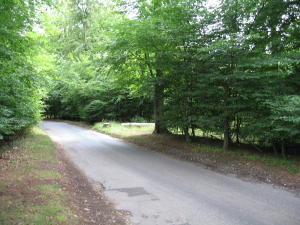
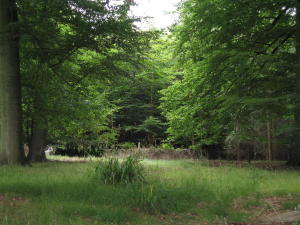
Pipers Wood today, hard to imagine the woods were once
full of temporary buildings and a large camp for many years after the
Second World War
After the War, there was a huge shortage of housing. This
is one of the reasons why the camps above stayed in existence for so long
after the war. In order to meet the housing shortage, the government
introduced the prefab house. Nationally about 160,000 were built. They
were built in sections in factories, which could then be quickly erected
on site. In Amersham, estates of these houses were built at Finch Lane and
White Lion Road. The last at Finch Lane was not vacated until the late
1980s. The Chiltern Open Air Museum at Chalfont St. Giles has restored a
prefab from Finch Lane and a picture can be seen on their web site here . For some
pictures of the Prefabs on White Lion Road, see here.
If anyone has any memories of living in the prefabs or pictures, please email the web master
Barbara Thomson, now from Staplehurst, Kent
has written and says "I was born in the Pipers Wood camp. We
moved to the prefab St. Georges Estate, White Lion Road when I was about
2 years old and stayed there until 1961 when they were demolished and we
were re-housed in Elizabeth Avenue where I stayed until I got married in
1972. I have very happy memories of the prefabs. There was one car owner
and the car was an old Austin 7. The owner would frequently drive
about 6 children to Brownies at the village hall. We took turns to
stand on the running board during the journey. This was incredibly
exciting and no-one thought anything wrong of it at all! I can
remember playing wonderful hide and seek games which involved creeping
through all the gardens and houses to get to the communal play area
which was a large concrete pitch surrounded by grass. There was an
electricity substation and we would climb on the top and watch for the
hiders and seekers gradually creeping in. This game was played all
through the summer holidays. I can also remember the Truancy
Officer, a scary man with red hair. He would appear and haul any
offenders off to school. We had big parties with many families
joining in and on Bonfire night a huge fire and fireworks was organised
down on the play area."
As well as the camps mentioned above and prefabs, the
Amersham area also had another "solution" to the housing shortage, again
like the prefabs and camps. This was in the form of the Beech Barn "Top"
and "Bottom" Camps. Little evidence remains to show the Beech Barn camps
existed. They occupied an area off the Amersham / Chesham Road where today
'The Leys' development is and part of the Beacon School are located. If
anyone can provide any pictures or memories, then again please email
the web master.
Owing to the housing shortage, many without suitable housing shared with
friends or relatives. However, some realised they could make use of former
camps that were becoming empty after the military moved out. Two such
places in Amersham were the beech Barn Camps.
I am grateful to Dave James, now living in
Australia, for providing the following information.
"The families that needed homes and their attitudes during that
time
When I look back now and realize - from stories that were eventually
told to me after the event - that during that terrible time of worry and
fear to many parents as the war ended in its final, but still uncertain,
conclusion, I can recognise now how those parents, many living at the
time in rented, though sometimes so-undesirable and unsafe lodgings,
were overjoyed to discover that there was a way to have a 'home of their
own' if homeless folk were determined to 'fight' for their rights and be
prepared to live in 'squalor' while they waited for the opportunity of
their 'Dream-House'.
As was similar all around the UK, thousands of families had tried to
take advantage of the former military camps to try and better their
lives, and some families, as was similar to my own family's story, had
'landed up' in the Amersham area, and were so very grateful to
eventually find a 'home' in one of the local camps after the terrible
times of WW2.
Who cared if the huts were freezing cold, had condensation running down
the inside of the roofs, were bare of any furniture, had no interior
walls, no lighting and no running water and were made of wood, tin, or
asbestos. (Three of the huts were constructed of asbestos in the Beech
Barn 'Top' camp at the time). To the desperate families of the time it
was somewhere to live!
As a future record; most of the families were not 'begging for help'
from the Government. They were all mostly hard working folk, and my
family would have been a good example of the situation at that time in
the camps: My Stepfather (Mr. Z Kissman and Polish) was a labourer, then
later a shoe repairer. Bertram James Challis, my Step grandfather (and
one of the famous 'Challis' family from the 'steam' days), was a JSSC
(Latimer) steam Boilerman. Annie Kate (his wife) was a cleaner at the
Regent Cinema, and their son, James, became a projectionist at the same
cinema after he left school. My Mum, Elizabeth James (later Kissman,
then Barry) was an usherette also at the same cinema, as well as a
counter-girl / waitress for the Darvell's Cafe / Tea-rooms in Amersham,
and a cleaner for both a local solicitor (Panton) and a doctor (Wise).
Finally, my Uncle Frank (Barnes) was a woodworker in a furniture factory
in Chesham - and all while we lived in the Beech Barn camps.
But my family wasn't the exception: There were also bus drivers and
conductors, an electrician, a lorry driver, a woodworker in a brush
manufacturer's factory, some council workers, a builder and builder's
labourers, secretaries, etc. at the camps. The family's young boys of
age still had to do their National Service at the time.
When I look back deeper, I realise that so many of those ordinary folk
who were struggling alongside us (us being my Mum, sister & myself)
for some kind of home in those days, had also done and sacrificed so
very much towards a final peace and our safety so that we could all
hopefully get on with a safe life. I can so well recall the many medals
and ribbons I saw. Both soldiers & ex-soldiers were so happy to
proudly show us little boys (I was only a youngster at the time) their
medals and tell us of their experiences in typical 'hero to young lad'
style. But there were others who didn't talk much about their wartime
experiences, and my Uncle Frank was one of them. Although I was a
typical young lad who would hang on to every word of the fighting war
that I could hear, Uncle Frank never talked to any of us about his
wartime experiences. But eventually when I was in my late teens I got
him to finally open up about his wartime activities and he soon had my
hair standing on end as he described some of his narrow misses while
laying telephone lines of communication, etc. over in Europe.
The Camps:
The Pipers Wood Camp
Piper Wood consisted all of wooden huts (as I recall), and was
apparently built for British troops during the early stages of WW2. Then
American troops stayed there for a while and finally the returning
troops were housed there until better homes were found for them. (Also
reported ex prisoners of war used the camp). The road wound down through
the wood, over the Metropolitan railway line, and came out on the main
Amersham to Aylesbury road somewhere near Little Missenden. Eventually,
for some reason, in the very late 1940's the Piper's Wood camp was
closed down (and I well recall us 'Squatters' from the Beech Barn camps
going to that camp one night and 'salvaging' huge amounts of ex-army
furniture which was to be burned the next day by order of the
Authorities in Charge!). (Note, by webmaster - my father in the 1950s
can still recall buildings in Pipers Wood, so did it find another life
from the 1940s to 1950s, or was it derelict until pulled down?)
I am grateful to Bernard Tyrell
of Newcastle for sending the below Identity Card issued to a member of
his family who was born at the Pipers Wood Camp
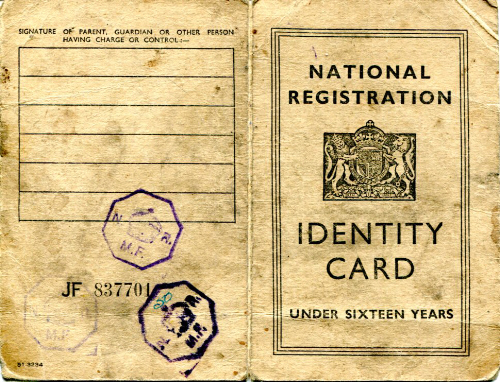
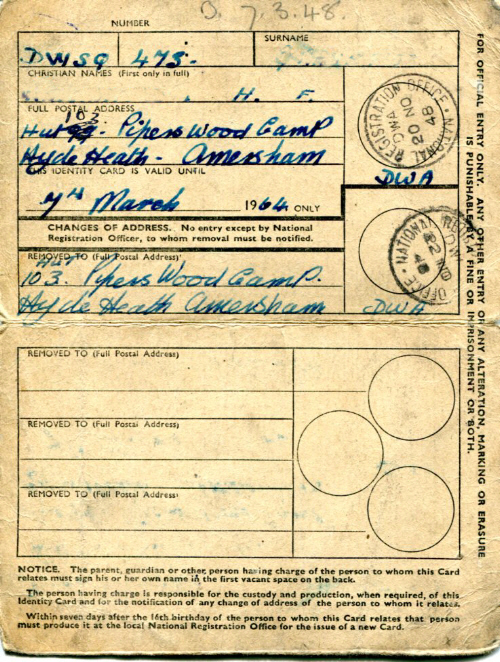
The Beech Barn 'Top' Camp
Beech Barn "Top" Camp was in the area on the left of the Chesham /
Amersham road, where 'The Leys' housing area is at present. It was
bordered on one side by that road, another by the Beacons Boy's school,
a third side by the rear gardens of houses in Oakway Road, and the
fourth side ran along Mayhall Lane, and consisted of wooden, tin &
asbestos huts.
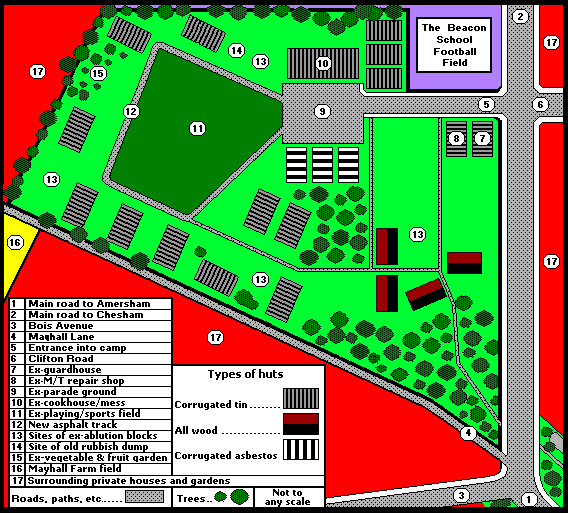
Diagram of Beech Barn Top Camp.
Copyright Dave James
The above diagram is based on the layout of Beech Barn Top Camp in
1948. At this time, the camp had been taken over by Amersham Council
and all the huts had been renovated. The large cookhouse / mess hut
was just left there by the Council at first, maybe with the thought
that it might be useful to the people on the camp, although it was
never used except as a playground for the children. It was eventually
pulled down somewhere around 1949-50 (could it be that it was realised
the place posed a risk after Dave James got shut up in one of the big
ovens and nobody knew he was there for quite a while?) The ablution
blocks had been pulled down as soon as all the huts were finished
being renovated, but the large water tanks on towers were still
scattered around the camp until they too were all pulled down about
the same time as the cookhouse / mess was demolished. There was also
an old overgrown vegetable and fruit garden down one side of the camp.
All the families had there own vegetable gardens near their huts. The
youngsters often enjoyed themselves eating the surviving apples,
pears, raspberries, blackberries, gooseberries, etc. that seemed to
still grow on the old vegetable and fruit garden .
The Beech Barn 'Bottom' Camp
The Bottom Camp (as us 'Top' camp folk called the other Beech Barn camp)
was in the area of the old Bois Farm (I believe). All the old farm
buildings had been utilised as somewhere for somebody to live and there
were also a number of tin Nissen huts around the inside perimeter of the
area. That area is now owned by the Beacon Boy's School. Apparently in
August 1946 both the Beech Barn camps, the Pipers Wood camp, and the
Vache camp at Chalfont St. Giles (these are the only four camps I know
of), were used as temporary housing areas for Polish ex-soldiers, who
were said to have fought with the Allies in Italy, and their 'Italian'
wives. Later it was apparently disclosed that the 'Italian' wives were
really the soldiers' own 'Polish' wives.
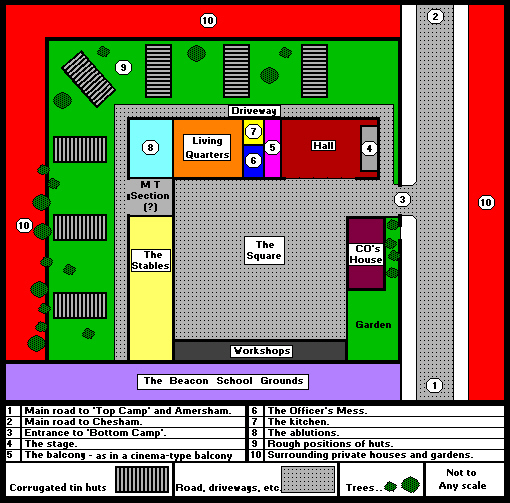
Diagram of Beech Barn Bottom Camp.
Copyright Dave James
A diagram of the Beech Barn 'Bottom Camp' during 1948 after being
taken over by the Amersham Council and having the corrugated tin huts
renovated by that council just prior to that time. This camp was
probably called the 'Bottom Camp' only because it was the most
down-hill of the two Beech Barn camps along the Chesham / Amersham
road.
In 1946/7, 'Squatters' (at that time, people who had nowhere to live
mostly due to the shortage of housing after the bombings of WW2) had
moved into any empty derelict building, house, room, factory, shed,
etc., around the country where they could find shelter as they began
to search (or wait) for some better accommodation.
In the 'Bottom Camp' of Beech Barn during 1946-7, families were packed
into both the 'Living Quarters' area and the 'CO's House'. One family,
with a small son, lived in a room called (at the time) 'The Officer's
Mess'. Another family lived, already with a very small baby girl, and
expecting another baby, on the sloping stairs / seats of 'The
Balcony'. The parents were desperate. Meanwhile, after hearing through
the local paper of the accommodation opportunities being offered by
grabbing some kind of existence in the camps, the mother of a small
family (mother, son & daughter), had decided to abandon a 'safe'
rented room in Amersham and give the 'camps' a go. She & her small
family had first lived on the 'Stage' of 'The Hall' (the Hall had
apparently been used as an entertainment / dancing center for local
forces stationed in the area), then moved into the ex-'Officer's
Mess', and had then finally moved down into the horrifically
rat-infested cellar under the ex-'Officer's Mess' as situations
changed and others became desperately in need of somewhere to live. At
that time, even though so many people were trying to find
accommodation or some kind of safer existence, everybody helped
everybody to eventually achieve a much better and safer life. Thanks
to the help and encouragement received from fellow camp residents,
Amersham Council of the time, the local hospitals, and many others
(teachers, doctors, clerics, employers, police, etc.), all the
Squatters were fairly happy and content to stay in the camps until
their turn eventually came around to be given a 'real' house to live
in. After the Amersham Council took over the camps, renovated the
huts, and sorted some of the families out into other accommodation,
nobody needed to live in the Hall, Officer's Mess, Living Quarters,
etc. areas, and those areas began to become derelict until taken over
by the Beacon School after the camps closed down.
Pictures of the camps and stories of living there can be found on Dave
James' site here
Very soon the local homeless folk began to discover about the camps
and moved in to the huts (or anywhere else in the camps they could get,
such as the Officer's Mess, the Hall, the Sergeant's Quarters, etc. in
the Bottom camp alone) so that they were there ready to dash into a hut
as soon as it was vacated when the Polish soldiers were moved out.
Apparently none of the local folk complained and the ones who managed to
get into a hut on any of the camps were just happy to wait in line for
their own eventual 'dream-home'. Eventually in the very late 1940's the
Piper's Wood camp was closed down as already mentioned and the Amersham
Council took over the two Beech Barn camps. I don't know what happened
to the Chalfont St. Giles camp although I do now know that there was a
bit of an upset between the local authorities and the local homeless
folk.
I remember that the council person in charge of allotting us huts, then
later houses, at the time was a Mrs. Massalonis - pronounced as I've
spelt, but maybe spelt different - we thought of her as a goddess and
saviour who would give us our longed-for 'Dream home'!
Under the guidance of her and the Amersham Council, all the huts, which
up until that time had been 'barrack-style' - just an empty shell - were
given separate rooms inside using breeze-block walls, each consisting of
usually three small bedrooms, a proper toilet and bath room (no more
going out to the Ablution Blocks of which there were about 3 in the
'Top' camp), a kitchen, and a living room with a large cooking/heating
range and oven. It was luxury to us at the time!
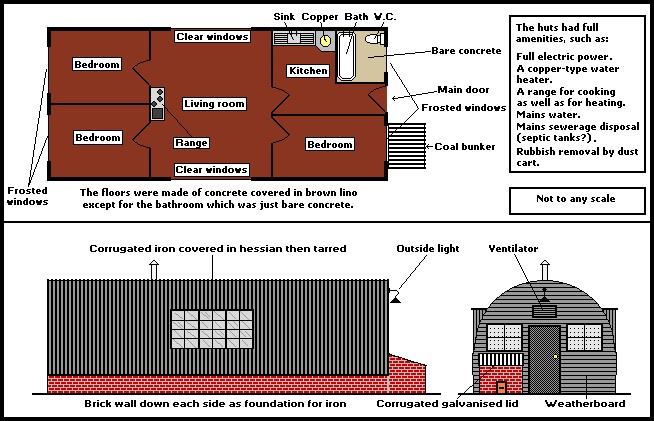
Diagram of Corrugated Tin Hut Layout,
Copyright Dave James
A diagram of a corrugated tin hut layout after the Amersham Council
had finished renovating it ready for a family to move into. A marked
improvement on the previous layout of a bare hut with just a
pot-bellied stove in the centre. This layout was typical of how all
the huts were made more livable on the two Beech Barn camps. The
wooden huts in the Top Camp were different from the above diagram in
that they were divided into two homes, with a family living in each
half and having their own front door at each end.
During the next 4 to 5 years most of us families lived happily on the
camps waiting for the day when we would be given a 'real' house, and
gradually over those years some families were moved out to houses and
other families moved into the vacant huts. Then, in the middle of 1953
the families began to be moved out in earnest and, what was more
promising to us was the fact that the huts were being demolished after
the families were moved. Later that year our dream was realised and we
were finally given a house.
By the end of 1953 the 'Top' camp was no more and, as us youngsters
passed by on the way to church (Our Lady of Perpetual Succour - the
Catholic church just down the road) we'd gradually see that the area was
finally cleaned up and turned into the lovely area it is now - The Leys.
As for the Beech Barn 'Bottom' camp: I know that it was still going
during the latter part of that year when we would walk by on the way to
that same church while already living at our new home in Weller Close -
at that time I had a 'girlfriend' from that camp and she often invited
me to her hut after the church services. But, by the new year of 1954 I
lost touch with her and I never went back to either camp again until it
was well & truly too late and all traces of the camps were gone. "
As can be seen from the above, it must have been like
living in a different world and there is no trace today in Amersham of
these areas, which must have housed hundreds. If anyone has any memories
or further information about these camps, we would be delighted to hear
from you. I believe it is important to record these memories so we can
appreciate what life was like during the time. Please email
the web master
You can read more about Dave James here
How things have changed. What we take for granted now could only be dreamt
of in the 1940s and 50s and something perhaps could not even be dreamt of!
For example, most people now have a mobile phone, in the camps there were
no telephones at all. The nearest was in Chesham Bois.
Jennifer Abeledo nee Hartley
has provided the following details "I was born on the 4th August 1946. My
mother, Margaret Valerie Hartley, told me that on August 18th 1946 she
demonstrated with me in my pram, along with my father, John Douglas
Hartley. They consequently occupied a nissen hut at Beach
Barn. She also told me that a photo of me in my pram was featured
on the front page in the national press. I haven't been able to verify
this. We must have stayed for at least three to four years at Beach
Barn as I remember moving into the New town of Hemel Hempstead when I was
four years old. We were among the first fifty families to be moved to the
new town. circa 1950. I do remember the nissen hut being black and
semi circular, also it seemed very long and open with no separate rooms, I
could see my parents from my cot in the middle of the room. I also
remember an upright piano against the left hand wall. We also
had a St Bernard dog, I used to ride on his back! I believe we were
among the first families to occupy the site at Beach Barn.
I now live in Gran Canaria with my husband and my mother is still alive
and living in Hemel Hempstead."
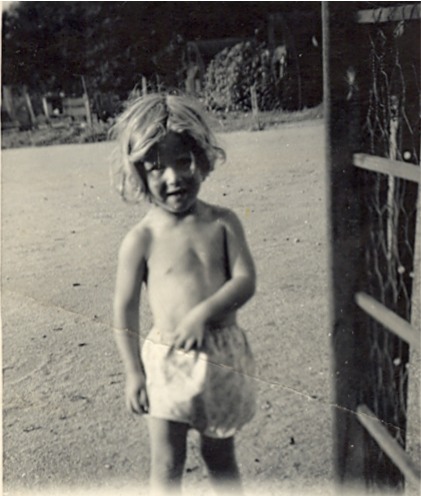
Picture courtesy of Jennifer Abeledo - A picture of Jennifer 4 years old
at Beach Barn
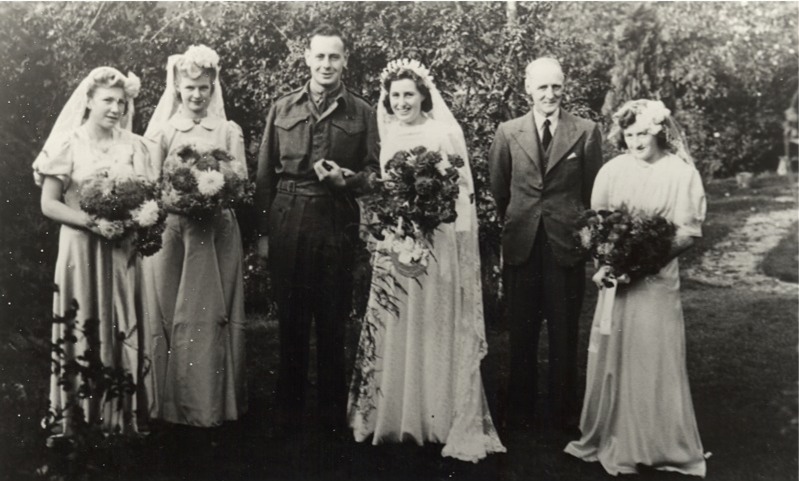
Picture courtesy of Jennifer Abeledo - Jennifer's parents' wedding held at
St. Mary's Church, Old Amersham on 13 October, 1945. Jennifer would
love to hear from anyone that remembers her family.
For some details about the Prefabs in Amersham, see here
Any additions, corrections, alterations, please email
the web master
Amersham Home Page
This web site is Copyright
and operates a privacy
policy
please also see disclaimer